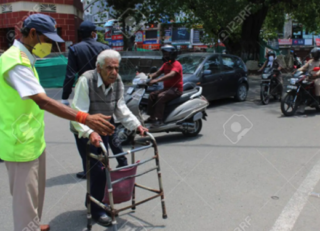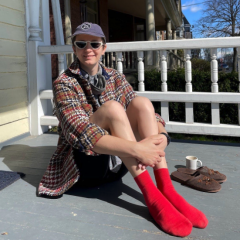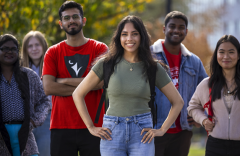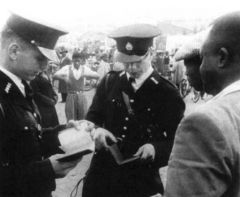Describing People in Alt Text
Let’s talk about people
I used to live in a small village in rural Nova Scotia. There was no longer a bank in the village because the last branch had been robbed several years ago. The bank, feeling it could no longer secure its money, shut up shop. The perpetrators were never caught. Nova Scotia’s finest investigated, but the witness statements from customers and staff referred to the robbers as being very tall, but also very short, all blond and all dark-haired, they were slender and they were broad. (The only thing all the witnesses could agree on was that the robbers all had “big city accents”.)
Far and away the aspect of creating accessible content that is most nuanced and complex is the creation of alt text. Whether to apply alt text in the first place, what to write, the level of detail, and the length of description – all these represent pitfalls that can potentially hinder the comprehension of the image for people. But the fact remains: no area of accessibility is more important than alt text for the rich description it can offer people using screen readers of images otherwise not visible to them. When it comes to writing alt text for images with people featured in them those pitfalls multiply.
How, you ask yourselves, does this relate to the witness statements from a robbery that happened over thirty years ago? Because the only thing those witnesses could prove beyond reasonable doubt was that describing people is difficult and often conflicts with other people’s ideas of who they are looking at. As pictures of people appear everywhere on the internet, and as those pictures need alt text, we have to tread a careful path in creating these descriptions.
First things first: Do pictures of people even need alt text?
Some might think that if pictures of people have no alt text – are not, in other words, mentioned by screen readers – it doesn’t matter. If a person appears on a website then it is not their appearance that matters, surely, but their role in what is being talked about on the page. If you are reading an online news story about an escaped criminal, or a profile of a professor at Carleton University, you don’t need to know what the person looks like, surely, in order to understand what is being said, right?
Think about it in terms of being a person with enough sightedness to be able to see images but finding all websites feature no pictures of people, even though the text is talking about them incessantly. We immediately want to know what the people described in the news story or the faculty profile looks like and would find it frustrating to not know. We might google the people to try to find their image elsewhere (which means they might not return to that original page). Just because some people rely on a screen reader doesn’t mean they don’t share that curiosity about what a person looks like. Aside from that very human itch waiting to be scratched, there are other reasons a person wants to know what an individual looks like – as we will discuss below.
More reasons than you think
Alt text is the way not only people with visual disabilities access images – it helps everyone if an internet connection is providing poor connectivity and images fail to load on a page. It is the only way we will know what is in an image if it doesn’t have a caption. This also applies to folk who switch off images – some aspects of neurodiversity mean people sometimes find it easier to browse with images switched off, creating a less crowded, overwhelming page.
Using alt text is a useful additional way in which to improve your website’s search results ranking. Mentioning descriptive terms that map to search terms will boost the positioning of your site when people google particular terms. For example, if you use the alt text A businesswoman in a suit steps from a chauffeur-driven limousine outside a bank that will help with searches around businesswomen, banks, limousines, chauffeurs, and suits.
Describing images is storytelling
There are other reasons to describe images, beyond the right for everyone to have an idea of what a person in an image looks like. With alt text you are telling a story, informing people, and providing context.
Sometimes it is only with a few descriptive words that the meaning of an image becomes apparent. Let’s look at an example to illustrate this.

Imagine the alt text for this image reads: a man helps another man to cross the street.
If you cannot see the image, this will raise questions – why is one person assisting another? Usually, people don’t need help crossing the street. In what scenario would someone need this help? Why is someone taking time out of their day to help someone do something that usually requires no assistance?
Now think of the instant comprehension associated with a more descriptive piece of alt text:
A man in a hi-vis vest assists an elderly man, who is using a walker, across a busy street.
This context creates an instant context and explanation for the scene. The man being helped is elderly AND he has a walking frame. Additionally, the man helping him is wearing a high visibility jacket – perhaps denoting that he has an official role he plays, perhaps as someone there to specifically assist the elderly to cross the road.
Pitfalls and landmines
Of course, when we are aiming to describe a person we have to be sensitive about the choice of words. There are endless ways to create offense, especially if the person in an image we are using on a website is a person known to the institution (as opposed to the nameless victim we find in stock photography).
Let’s look at this photo

The alt text on the image is An aging, balding white man with glasses outside, with a bridge and a canal in the background.
The man in the photo might not wish to be referred to as aging or balding. Perhaps a better piece of alt text might be A middle-aged white man outside with glasses, with a bridge and a canal in the background.
The aim is to describe someone accurately without being personal. Let’s look at some other examples. This is from the Instagram account of Shannon Finnegan, an American artist with disabilities.

The alt text for the image reads:
Me, a white person in my 30s, sitting on a sunny porch. Outfit includes: Anti-Stairs Club lounge hat, triangle sunnies, a thick houndstooth button down, bare legs, bright red socks. Next to me are my dollar store slippers and a tiny cup of coffee. Wide smile for Yo-Yo who is taking the photo.
This creates a very evocative image of Shannon Finnegan.
Race is crucial
Your first question might be: Why do we need to mention the race of an individual at all? There is a great explanation of the reasons in this article by Tolu Adegbite. In summary, she outlines how the mention of race equals representation, in a world that often promotes whiteness as ‘the norm’. She gives a great example of Haben Girma, an African-American woman who is both blind and deaf, and who attended Harvard Law School. She notes how many blind people assume she is white because her race is not often mentioned in alt text on images of her. As her race is rarely mentioned in alt text, many assume she is white – like many universities in the western world, Harvard, due to its own admission policies, has historically been associated with white people, after all, and people make assumptions about who makes it to law school in the first place, with that intensified when it comes to Harvard.
In our context – describing images commonly used at a university – the following image can tell radically different stories. If the alt text is Six Carleton students face the camera it tells us far less about Carleton than if it were Six Carleton students – including people who are black, south Asian, east Asian and white – face the camera.

The reason for including the description of a black, South Asian, East Asian etc. person is also why it is important to include the descriptor white when writing alt text for an image that includes white people. Unless we do that it signals that we only mention people’s race if they are not white as if any other racialized group is a deviation from the norm.
As well as representation, the use of race can add meaning. The following idea is borrowed from different examples used in Tolu Adegbite’s article. Consider this picture, presented with the alt text of A pair of police officers question two men:

Hearing this gives people a very general impression which could range from the benign to the positive. Changing the alt text to Two white police officers question two black South African men changes the meaning entirely. Used in an article about Apartheid-era South Africa, we are suddenly presented with a much more meaningful context, simply by mentioning the race of the individuals in the image. Now those using screen readers are given the same context as those who are viewing the image.
Learn more
In conclusion, although we have to be sensitive and thoughtful when describing people in photographs, whether in a caption or alt text, it is crucial we do give as full a picture as possible to those who cannot view pictures on the page.
But we can also embrace the task as a creative challenge. A great example of this is Shannon Finnegan and Bojana Coklyat’s workshop Alt Text as Poetry. Let us know if you have any great ideas or examples of alt text you’ve created of which you are particularly proud.